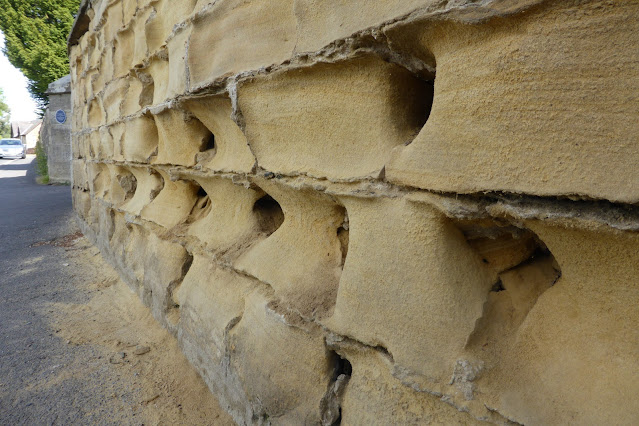Sandstone or limestone walls?
Thursday is a revisit to Sharow to checkup on the walls of the church - are they really made of sandstone?
Yesterday I had been looking at the west facing wall and - after discussion with the primary school children - noticed the erosion in the sandstone wall of the church. - erosion which I had not noticed earlier that day when observing the moth trappers emptying the moth trap
 |
| view from south - and note yew tree off the left |
Yet there is much more erosion in the perimeter churchyard wall.
 |
| Looking down on a broken capstone on the perimeter churchyard wall, showing it is made of a similar soft sandstone to the vertical part of the wall. |
I now need a name that I do not know to describe an architectural feature: - the sort of metre tall wainscott round a church
The wall at the base of an old building is wider near the base , the the wall gets a bit thinner a metre up,
Like a wainscott.
And there is a sort of capstone at the top of where this happens.
In the Limestone building at Malham Tarn House, this ridge is made out of (acid) sandstone - hence my expectation that this ridge would be acid here.
I went round the back of the church where I had found what I thought was Pertusaria albescens -var coralloides. - the white patches
 |
In the dales I have found my found P albescens var coralloides on sandstone rocks - often in mixed limestone and sandstone walls - had made me assume that the sloping stones were made of an acidic sandstone.. but ..
 |
| Pertusaria albescens var coralloides - possibly |
 |
| A Garden Carpet moth |
I looked carefully, the "Sloping" stones were not separate stones at an angle, but just stones carved with the top edge sloping. Some parts of the black had eroded to reveal yellow sandy material inside. The dark colour of the sloping parts was due to the lichen and algal growth and biofilm on them.
This interesting Lecanora was growing there too.

 |
| This photo includes part of the new wing with the new toilets |









No comments:
Post a Comment